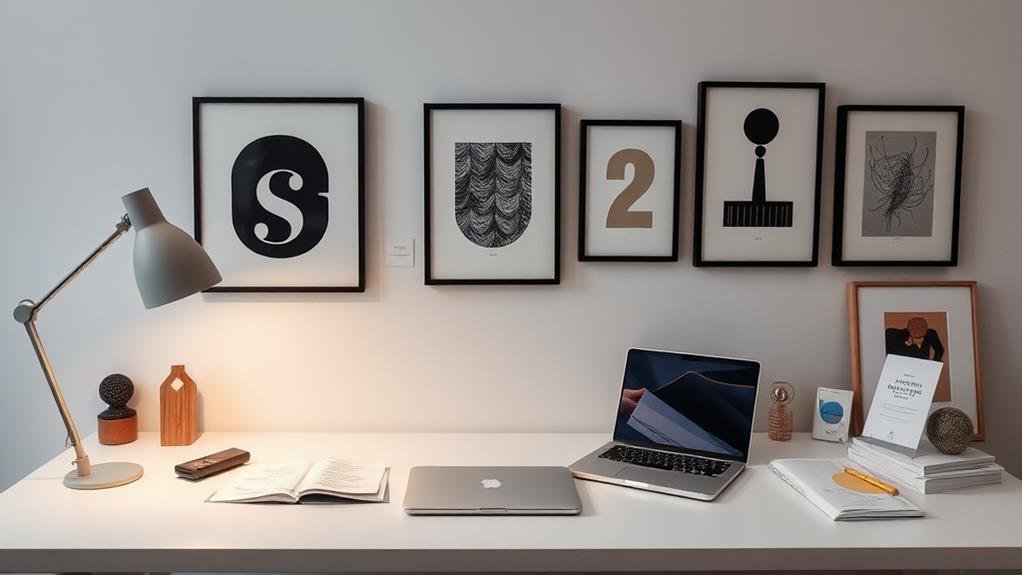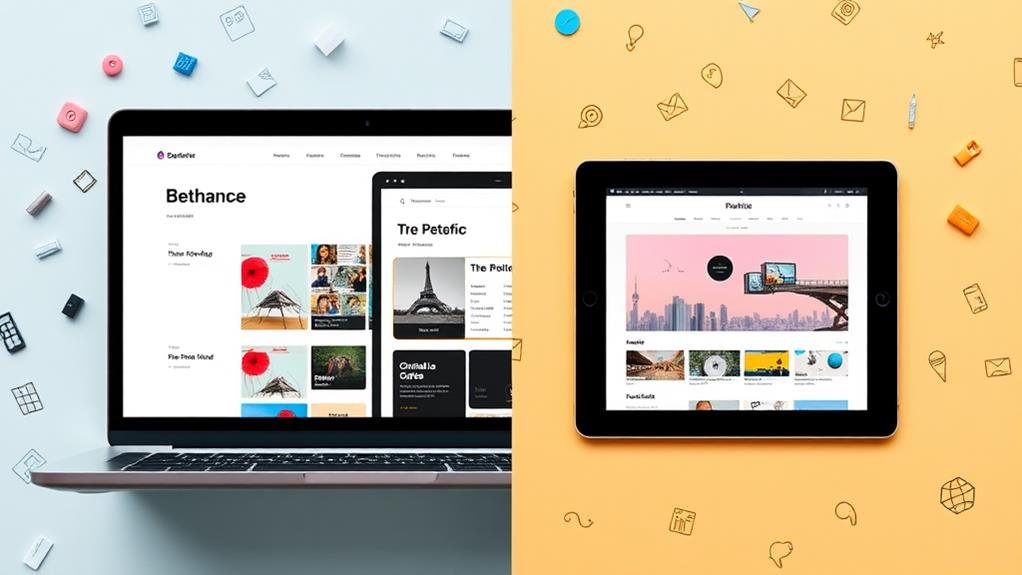
To showcase your portfolio items effectively, you need to think beyond just listing your projects and instead, create a strategic narrative that demonstrates your problem-solving skills, design process, and value delivery to clients and businesses. Mix it up by including a mix of design styles, skills, and process to cater to different tastes and preferences. Use metrics, case studies, and high-quality visuals to tell a story that highlights your achievements and expertise. By structuring your portfolio with a simple and easy-to-scan design, you'll be able to grab the attention of potential clients and show them the value you can bring - and that's just the beginning of building a portfolio that truly stands out.
In regards to landing your next design job, your portfolio is your ultimate sidekick.
Crucial to grasp is that a design portfolio is a showcase to the world, and it will potentially get you your next job.
A well-crafted portfolio showcases strategic problem-solving skills and understanding of how design delivers value, which is what clients want to see.
Having a portfolio site is vital for creatives like you to showcase their work, allowing potential clients to assess their skills and experience.
A well-maintained portfolio can increase credibility, demonstrate expertise, and attract new business opportunities.
It can also help you track your progress, identify areas for improvement, and refine your skills over time.
Your online portfolio website is where you can establish a personal brand and build a professional reputation.
By showcasing a range of projects and experiences, you can set yourself apart from competitors and make yourself more attractive to potential clients.
Three minutes - that's all the time recruiters spend on a candidate's portfolio, scanning for rich visual content and impactful design work.
That's why tailoring your portfolio site to your target audience's needs and preferences is crucial. As a designer, you want to create an online portfolio that speaks to potential clients, showcasing your design skills and experiences.
To effectively target your desired audience, organize your work into categories or projects, making it easy for visitors to find and view relevant portfolio items that align with their interests or needs.
Use high-quality images and visuals to grab their attention and communicate your skills and expertise. Including context, such as project goals, challenges, and solutions, helps them understand your thought process and capabilities.
Your designer portfolio should provide easy ways for visitors to contact or hire you, such as a clear call-to-action, facilitating conversions and achieving your desired outcome.

You've got one shot to make a lasting impression with your portfolio, and it's essential to get it right.
A winning portfolio should showcase strategic problem-solving skills, understanding of how design delivers value, and stand out by solving business challenges.
To build a portfolio that truly stands out, remember:
When crafting your ideal portfolio, don't forget to include high-quality images and videos that showcase your work and its details.
Use metrics such as statistics about the project's impact or success to demonstrate the value of your work.
Now that you've crafted a winning portfolio, it's time to think strategically about its structure and content.
A well-planned design portfolio should have a simple, clean, and easy-to-scan structure, with 4-6 ideal projects that demonstrate your strategic problem-solving skills and understanding of how design delivers value.
Start with a brief introduction, listing your experience, key achievements, and skills.
Organize your work into categories or projects, and include case studies that provide in-depth explanations of projects and their outcomes. Providing context about the project's goals, challenges, and solutions helps visitors appreciate the complexity and value of your work.
Incorporate high-quality visuals, including images and videos, to showcase your work and its details.
You can use a portfolio builder or website builder to create a website portfolio with a custom domain, making it easy to share your portfolio sites with potential clients.

Crafting a compelling narrative is crucial to showcasing your portfolio items effectively.
You want to tell a story that highlights your strategic problem-solving skills, design process, and understanding of how design delivers value.
To do this, consider the following techniques:
In respect of showcasing your design skills, it's not just about presenting your work – it's about strategically highlighting your strengths and versatility as a designer.
When crafting your design portfolio, prioritize showcasing your best work, and curate it to demonstrate your problem-solving skills and understanding of how design delivers value to clients and businesses.
Include case studies that provide in-depth explanations of projects and their outcomes, highlighting the design process and challenges overcome. Use high-quality images and videos to visually showcase the work and its details, allowing visitors to understand the design decisions made.
Organize your design work into categories or projects, making it easy for visitors to navigate and understand the scope of your design skills. By doing so, you'll create a perfect portfolio that showcases your graphic design, user experience, and ease of use skills, increasing your chances of attracting potential clients and opportunities.

When building a design portfolio, it's easy to fall into common traps that can turn off potential clients and opportunities.
To avoid these mistakes, it's vital to be mindful of the following:
1. Inconsistency: Make sure your portfolio showcases work that reflects your brand style guide.
If it doesn't, it can suggest a lack of consistency and attention to detail.
2. Unfinished projects: Remove any "coming soon" pages from your project gallery, as they can be frustrating for visitors.
Only show work that's complete and ready to be showcased.
3. Lack of creativity: Avoid using a dull, templated format for your case studies.
Instead, make each one unique and engaging, showcasing your design skills and creativity, which is crucial for success.
Now that you've avoided common portfolio mistakes, let's focus on building an online portfolio that effectively showcases your design skills and creativity.
To create a website that truly represents your work, you don't need to be a coding expert. You can create a website with no coding using popular portfolio builders like Format, Writers Residence, or Portfoliobox.
These platforms offer a lot of features, including the ability to add video hosting, ecommerce tools, and a range of templates to customize your portfolio. Prices start at just $5.50 per month, making it an affordable option to showcase your work.
With your own domain name, you can establish a professional online presence that stands out from the crowd.
When building your portfolio, remember to organize your work into categories or projects, and include high-quality images and videos to bring your projects to life.

How do you choose the right platform to showcase your design skills and creativity? With so many options available, it can be overwhelming.
Three key factors to weigh when selecting a platform to build your online portfolio are:
Ultimately, researching and finding the right platform or approach depends on your individual needs and goals.
Your online portfolio is your digital storefront, and its professional presence can make or break your chances of landing your next job or client. To create a winning portfolio, you need to showcase your design skills, strategy, and soft skills through a well-planned web page. A simple, clean, and easy-to-scan portfolio with 4-6 ideal projects is recommended, starting with a brief introduction that lists your experience, key achievements, and skills.
| Portfolio Feature | Benefits |
|---|---|
| Include case studies, images, videos, testimonials, context, and metrics | Provides a comprehensive view of your work and its impact |
| Organize work into categories or projects and use high-quality images and visuals | Makes it easy for visitors to navigate and understand your skills and expertise |
| Use SEO techniques, make the site responsive and mobile-friendly, and use analytics | Improves the visibility and effectiveness of your portfolio site |
| Consider the pros and cons of self-hosting, using a dedicated social network, or using pre-packaged services or scripts | Helps in choosing the right platform for creating a professional online presence |
You're wondering how to best showcase your portfolio. To do so, tailor your presentation to your desired work, break it down into smaller pieces, and use high-quality visuals, metrics, and context to give visitors a deeper understanding of your projects and skills.
When showcasing product design in your portfolio, you're highlighting your problem-solving skills and attention to detail by walking viewers through your design process, from research to testing, and showcasing the final product with high-quality visuals and metrics that demonstrate its impact.
When presenting a portfolio piece, you'll want to break it down into manageable sections, include clear descriptions, visuals, and metrics to demonstrate impact, and provide context about the project, making it easy for viewers to understand and appreciate your work.
You're wondering how to make a portfolio display effectively. To do so, organize your work into categories, use high-quality visuals, and include concise descriptions, metrics, and testimonials to showcase your design skills and experience in a clear and easy-to-navigate way.
You've made it! You now have a solid portfolio that showcases your best work. Remember, your portfolio is a living document that evolves as you grow professionally. Regularly update it to reflect new skills, experiences, and accomplishments. By doing so, you'll attract potential clients, employers, or collaborators who appreciate your expertise. With your online portfolio, you're ready to take your career to the next level and make a lasting impression in your industry.